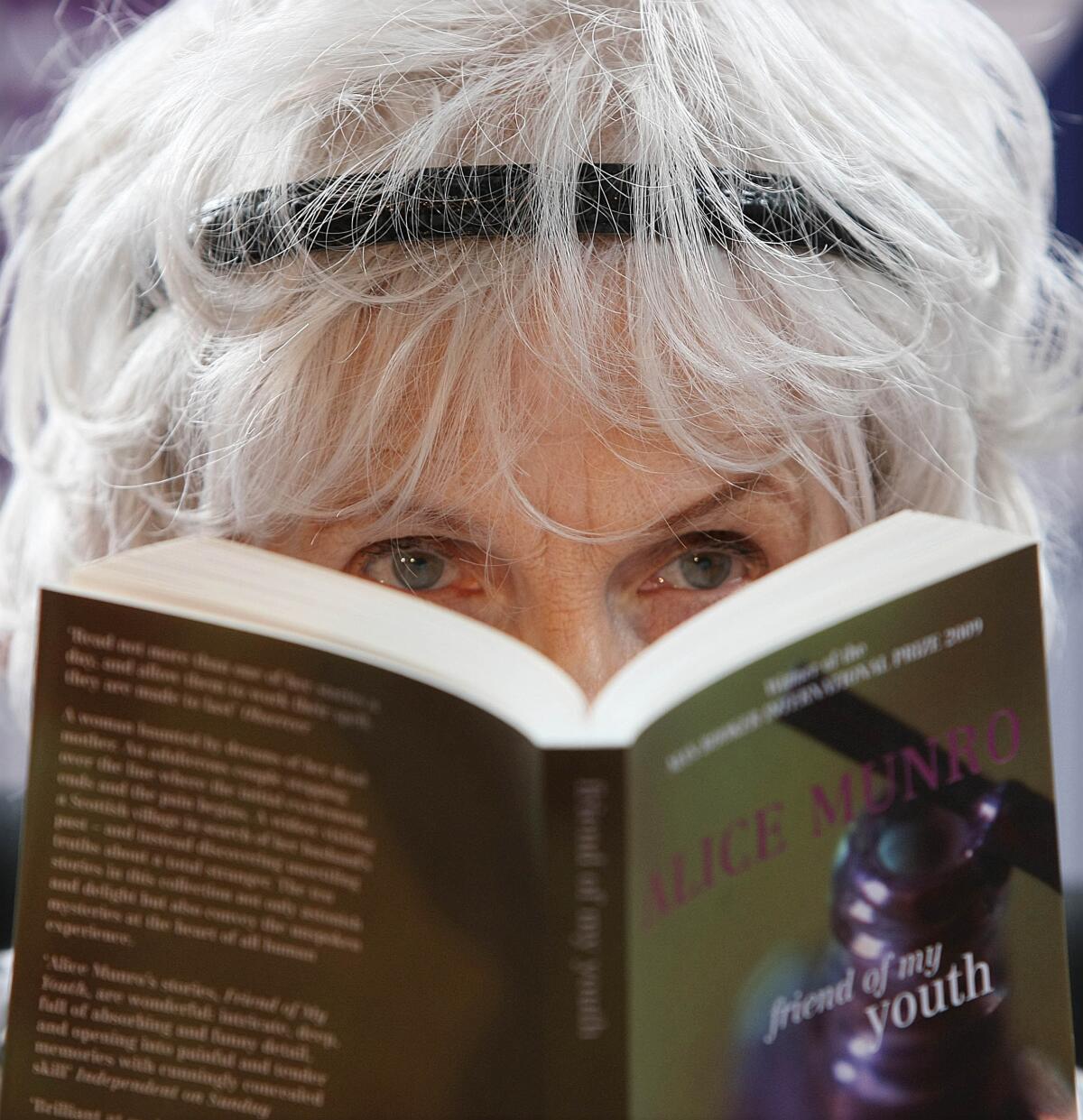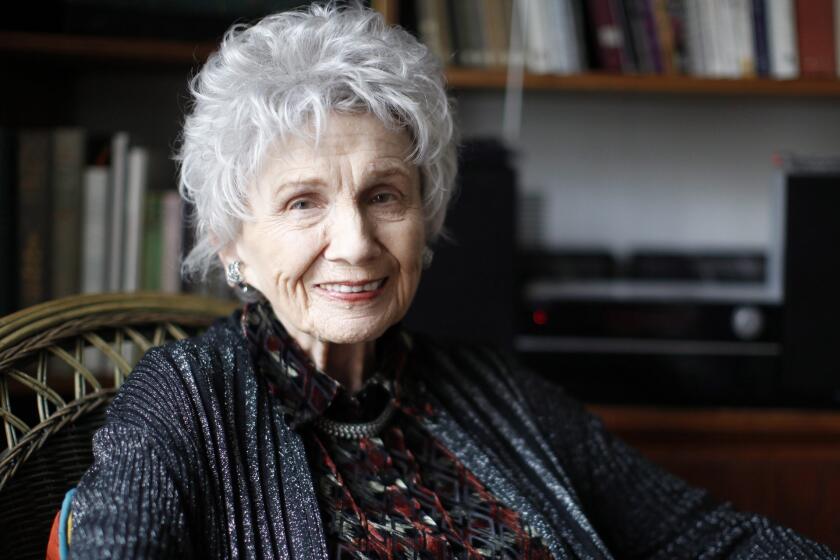Opinion: Alice Munro’s stories gave voice to women’s unspoken, almost unspeakable, inner lives

- Share via
I was 15 — a Canadian kid growing up on a diet of my country’s many remarkable authors and a would-be writer myself — when I first read Alice Munro’s “Lives of Girls and Women.” I skimmed that slim volume of short stories with the supreme haughtiness of youth. I remember thinking something along these lines: Women’s lives are nothing like that.
Less than two decades later, I would close the last page of that same book with a shiver, thinking to myself: Women’s lives are exactly like this.
Alice Munro, who died Monday at 92, saw our lives so clearly.
Alice Munro, the Nobel Prize-winning short story author known for ‘Dear Life,’ has died. She was 92.
Why did it take me so many years to understand the stories about women that Munro had to offer? My early adulthood began in the 1990s, at a time when young women were assured they could be anything. Wasn’t gender inequality yesterday’s news? Surely the fact that Munro was a celebrated writer was proof that the complex problems she wrote about were naturally becoming a thing of the past. I could appreciate the creative genius of her skills, but if women’s lives were such a problem, I was sure the problem had already been solved.
If I longed to ‘write my book,’ the first step couldn’t be ‘write my book.’ It had to be, simply, to write. Every day.
Sometime in my 20s, I began to realize the utter delusion of this view. I started to read her in earnest, this time with some humility. In her stories, I saw the lives of women I recognized — the university degree my grandmother longed for but could never earn, the TV production career my mother left when she got married, the lopsided power men wielded in the world. And I also saw my self-doubt, my relationships with decent, occasionally very damaged men, the conflict between my dreams for my own life and the competing demands of my own family. These things were almost unspeakable; they were as hard to characterize as the air. But Alice Munro made them real, and somehow the fact that these quiet revelations took place in parts of Canada I knew made them even more so.
Later, I saw her stories reflected back to me in the mirror of the lives of my patients, older women of Munro’s generation who would eagerly confide how happy and relieved they were to have a woman as a doctor. They often trusted me with the same kind of tales Munro naturally told, the ones that had seemed fantastical or overwrought before I began to understand the lives of girls and women.
Friendship bracelets helped ease the pain of leaving behind friends — and childhood. The ritual will be lost on my kids, who exchange digital tokens.
I once asked a patient in her 80s about the origin of a faint, knotted scar that ran down the midline of her lower abdomen. She told me she’d had a Caesarean section, when her one living child was born. Then, almost as an afterthought, she offered what was practically a Munro story: She’d once delivered a stillborn. She’d gone to milk the cows in the barn that day, worked harder than she intended. The next day the baby was born dead. She’d carried that weight for 60 years. She’d always blamed herself for the loss of that child, for being, as she told me in a soft voice, “such a damn fool.”
Munro’s stories often have these same types of somber turns. They are full of necessary revelations — about marriage and sex, childbirth and death, fidelity and recklessness and desire. But often their central events are private disclosures, small but consequential failures, confessed to the reader or some third party much later in life. And perhaps most importantly, her writing invites compassion for her narrators, who are often unable to muster it for themselves.
In inviting that compassion, perhaps her stories also opened the door to a crucial question, one that occurs to me only now. If we see ourselves in those narrators, aren’t we obligated to have some compassion for ourselves, too?
Not all of Munro’s stories were about disaster. Many of her finest, most unforgettable works are about the grenades that only briefly lost their pins, the grace of moments when a split second, good instinct or a stroke of luck shields a protagonist from catastrophe. They are moments when the children could have drowned but didn’t, moments that seemed primed for violence — until the storm cloud passed over quietly, carrying on to somewhere else.
That’s a woman’s life too, isn’t it? The constant, necessary vigilance against potential disaster. If the disaster never happens, a man can say all that fussing was just neurotic. But that’s a view from outside the fear, formed after the danger has passed. The ever-present threat of what could happen, wherever you are, whether crossing the street or the Atlantic: That tension defines a woman’s life. Not just a woman’s life, of course — men feel it too. But it is inseparable from a woman’s life, because women’s lives are so often about tending to everyone other than themselves.
There is a line in Munro’s short story “Wood,” and it is one of my favorites in her entire body of work. A man named Roy is cutting trees, and he steps into a hole. As he realizes he is about to fall and break his leg, Munro writes, “What happens to Roy now is the most ordinary and yet the most unbelievable thing.”
I think about that line all the time. Tragedy is ordinary as an event in human history — and only unbelievable when it touches us. A writer who wants to take us into that tragedy has to look after us well. That’s what Alice Munro did. And she made it look so bewilderingly easy, dissecting that plane between the ordinary and the unbelievable as expertly as any surgeon. She showed us life as a series of moments that can cradle or betray us, full of infinite, rippling aftermaths, the miraculous banality in the days we rearrange again and again and again before, someday, we die.
So that’s what I felt when I learned of Munro’s death — hardly a surprise at the age of 92. The most ordinary and the most unbelievable thing. It describes what happens every day in a hospital, and hopefully in a sparse handful of days of our lives. And it is also the space where the world’s very best writers dwell.
Jillian Horton is a writer and physician. Her first book, “We Are All Perfectly Fine: A Memoir of Love, Medicine and Healing,” is being adapted for television. @jillianhortonMD
More to Read
A cure for the common opinion
Get thought-provoking perspectives with our weekly newsletter.
You may occasionally receive promotional content from the Los Angeles Times.













